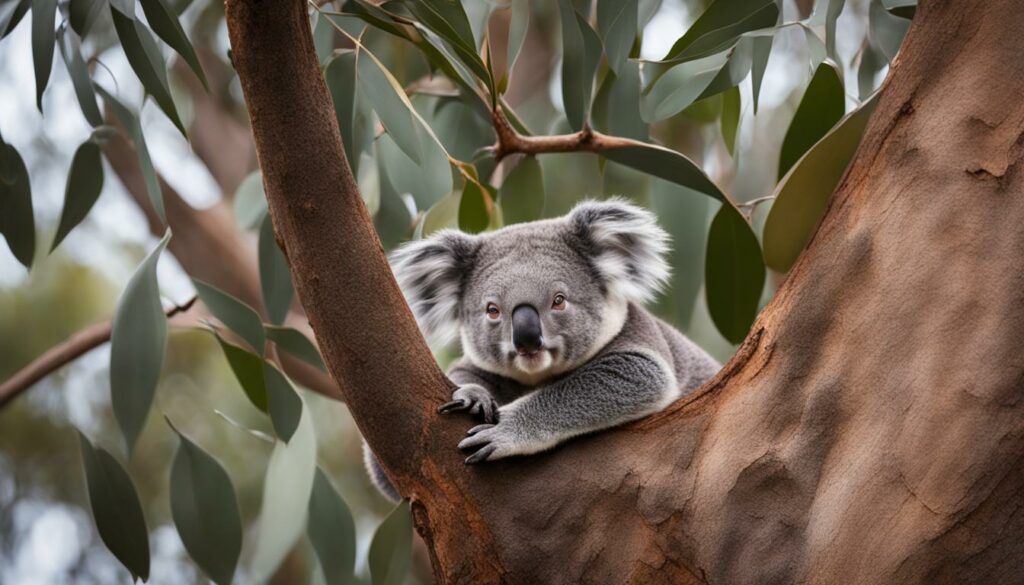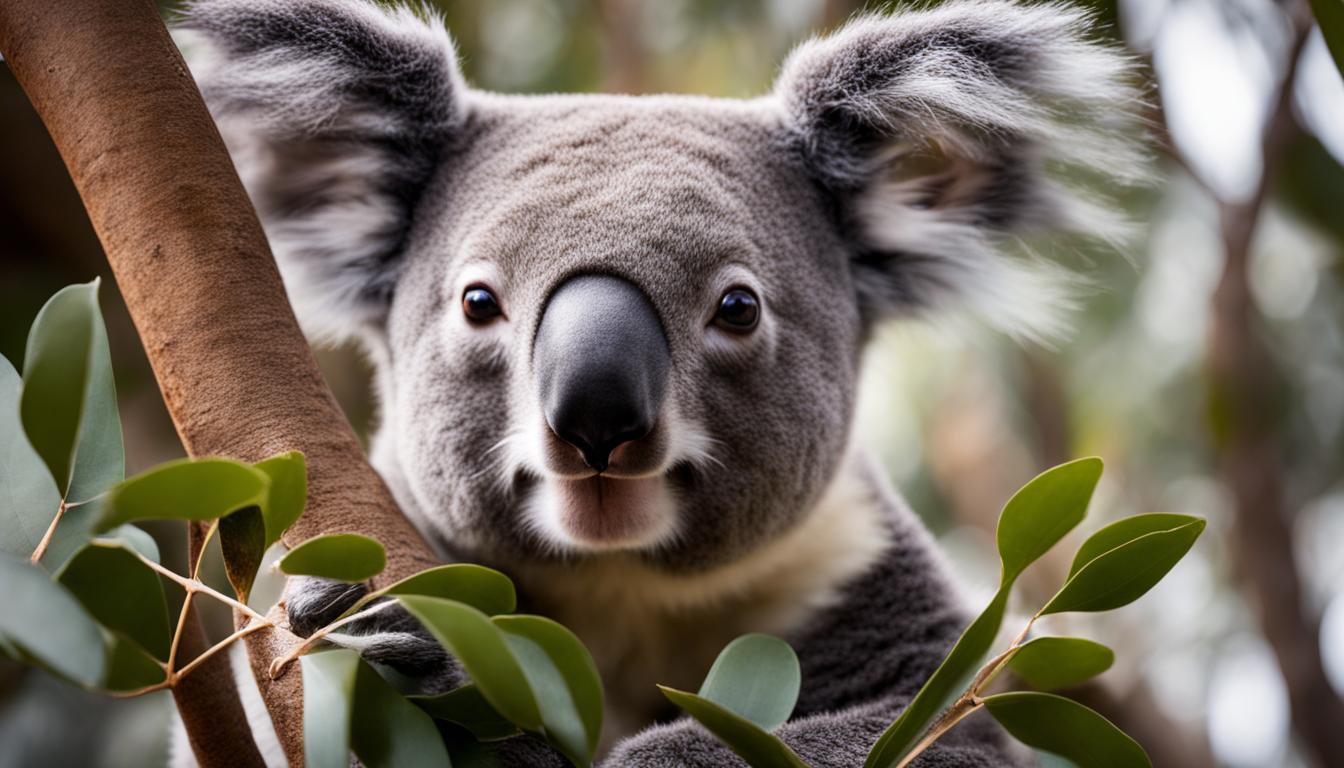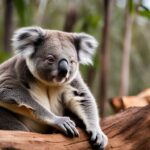Have you ever wondered why koalas have such unique fur? Their fur is not only a defining characteristic of their appearance but also serves important functions in their survival and adaptation to their environment. Let’s explore the role of koala fur and its coloration.
Koala fur has various characteristics, including patterns, variations, and colors, which can differ between individuals and populations. It helps the koalas in regulating their body temperature, providing camouflage, and acting as protection against the elements.
The fur is well adapted to their life in the trees. Its color and patterns help to camouflage the koalas against the bark of the trees, allowing them to blend in and avoid predators. The fur also provides insulation, keeping the koalas warm in colder temperatures.
Not only does the fur assist in thermoregulation, but the color of the fur also contributes to it. Lighter colors reflect sunlight, preventing the koalas from overheating, while darker colors absorb heat, keeping them warm in cooler temperatures.
Koalas exhibit a range of fur colors and patterns, such as grey-brown, silver-grey, or even golden, which can be influenced by factors like genetics, location, and age. These variations add to the uniqueness and individuality of each koala.
The color of a koala’s fur is essential for their ability to camouflage and blend in with their surroundings. The shades of grey and brown mimic the colors of tree bark, making it difficult for predators to spot them among the branches. The variations in fur color and patterns further enhance their camouflage by breaking up their silhouette.
The fur also provides protection against the elements, including rain and wind. It repels water, keeping the koalas dry. Additionally, koalas engage in grooming behaviors to maintain the health and cleanliness of their fur, using their specialized claws to remove ticks or debris.
Understanding the role of koala fur and its coloration deepens our appreciation for these fascinating creatures. Their fur is not only aesthetically pleasing but also plays a vital role in their survival and adaptation to their environment.
Adaptations for a Life in the Trees
The koala is a master of life in the trees, and its fur plays a crucial role in its adaptation to this unique habitat. With its specialized characteristics and variations, the koala’s fur enables it to thrive in its tree-dwelling lifestyle.
First and foremost, the coloration of the koala’s fur provides excellent camouflage against the bark of the trees. The shades of grey and brown blend seamlessly with the tree trunks, making it difficult for predators to spot them. This natural camouflage helps safeguard the koalas as they rest, feed, and move among the branches.
The fur also offers insulation, keeping the koalas warm in cooler temperatures. Its dense texture traps air, creating a layer of warmth around their bodies. This adaptation allows koalas to conserve energy and remain comfortable even during chilly nights or in cooler climates.
The coloration and characteristics of the koala’s fur are essential for its survival and success in the arboreal environment. The camouflage and insulation provided by the fur enable koalas to thrive in the treetops, ensuring their continued existence in their native habitats.
Fur Characteristics for Tree Life
Not only does the koala’s fur serve practical purposes, but it also exhibits various characteristics and variations. Some koalas have distinct patterns on their fur, such as spots or patches, which add to their unique appearances. Additionally, the color of the fur can range from grey-brown to silver-grey, further contributing to the individuality of each koala.
The thickness of the fur coat can also vary among individuals. Some koalas may have thicker fur, providing additional protection from the elements, while others may have thinner fur, allowing for better heat dissipation in warmer climates.
| Fur Characteristics | Description |
|---|---|
| Patterns | Some koalas have spots or patches on their fur, enhancing their unique appearances. |
| Color | Koala fur can range from grey-brown to silver-grey, contributing to their individuality. |
| Thickness | The thickness of the fur coat can vary among individuals, providing different levels of protection and heat regulation. |
These variations in fur characteristics ensure the koalas’ adaptability to their diverse environments and contribute to their overall survival in the trees.
Conclusion
The koala’s fur is not only a beautiful feature but also a remarkable adaptation for its life in the trees. Its coloration, camouflage, insulation, and variations in patterns and thickness all contribute to the koala’s ability to thrive in its arboreal habitat. Understanding the significance of fur in the koala’s adaptation provides us with a deeper appreciation for these incredible creatures and their remarkable survival strategies.
Role of fur in thermoregulation
The fur of a koala plays a crucial role in thermoregulation, helping the animal maintain its body temperature in varying weather conditions. The dense fur acts as insulation, trapping air close to the koala’s body and providing an extra layer of warmth in colder temperatures. This insulation is especially important as koalas do not have a layer of fat to keep them warm like some other animals.
During hotter weather, the fur also plays a vital role in protecting the koala from overheating. The fur acts as a barrier against the sun’s rays, preventing excessive heat absorption. Additionally, the color of the fur can contribute to thermoregulation. Lighter colors, such as shades of grey, reflect sunlight, helping to keep the koala cool.
The fur characteristics of koalas, including variations in color, shades, and hues, are not only important for visual appeal but also have functional purposes. The variation in color can help regulate body temperature by influencing the amount of heat absorbed or reflected. This adaptation allows koalas to effectively cope with the ever-changing environmental conditions they encounter in their natural habitat.
Grooming and protection behaviors
Koalas also engage in grooming behaviors to maintain the health and cleanliness of their fur. They use their specialized claws to remove ticks, debris, and loose fur from their coat. Regular grooming helps ensure that the fur remains in the best condition, providing optimal insulation and protection.
Understanding the role of fur in thermoregulation provides valuable insights into the remarkable adaptations of koalas and their ability to thrive in diverse environments. It highlights the complexity and importance of this unique characteristic, showcasing the invaluable role that fur plays in the life of these fascinating creatures.
Variations in Koala Fur Color and Patterns
Koalas are known for their unique and adorable appearance, thanks in part to the variations in their fur color and patterns. The fur of a koala can range from grey-brown to silver-grey, and some individuals may even have a golden hue. These variations in color can be influenced by several factors, including genetics, location, and age.
Not only do koalas exhibit a range of fur colors, but they also have different patterns on their fur. Some koalas may have patches or spots on their coat, adding to their individuality and uniqueness. These patterns can vary between individuals and populations, creating a visually diverse koala population.
To better understand the variations in koala fur color and patterns, researchers have conducted studies to analyze these characteristics. By studying the genetic makeup of koalas and their fur coloration patterns, scientists aim to unravel the underlying mechanisms that drive these variations. This research can provide valuable insights into the evolution and adaptation of koalas to their environment.
| Fur Color | Fur Pattern |
|---|---|
| Grey-brown | Spots or patches |
| Silver-grey | Uniform or mottled |
| Golden | N/A (no specific pattern) |
As koalas rely on their fur for camouflage and protection, the variations in color and patterns play a crucial role in their survival. The shades of grey and brown in their fur allow them to blend seamlessly with the tree bark, making it difficult for predators to spot them. Additionally, the patterns on their fur help to break up their silhouette, further enhancing their camouflage in the dense foliage.
Understanding the variations in koala fur color and patterns not only adds to our appreciation of these fascinating creatures but also contributes to our knowledge of their adaptation and survival in their natural habitat. By studying the characteristics of their fur, we gain valuable insights into the intricate and complex relationship between koalas and their environment.
Significance of fur color in camouflage
The color of a koala’s fur plays a crucial role in its ability to camouflage and blend in with its surroundings. The shades of grey and brown in the fur mimic the colors of tree bark, making it difficult for predators to spot the koala among the branches. This natural camouflage helps the koala stay hidden and avoid being detected by potential threats.
In addition to the overall color, the variations in fur patterns also contribute to the koala’s camouflage. Some koalas may have patches or spots on their fur, which further break up their silhouette and make them less noticeable. These patterns help the koala blend in even more effectively with the tree bark, providing them with a higher level of protection.
The significance of fur color in camouflage cannot be overstated. It allows koalas to remain hidden and undisturbed while they rest and sleep in the trees. By blending in seamlessly with their environment, koalas can minimize the risk of predation and ensure their safety in the wild.

Fur Color Camouflage Examples
| Koala Fur Color | Camouflage Effect |
|---|---|
| Grey-brown | Blends in with aged tree bark |
| Silver-grey | Mimics the color of tree trunks |
| Golden | Provides camouflage in certain lighting conditions |
Protection and Grooming Behaviors Related to Fur
The fur of a koala serves not only as a means of camouflage and insulation but also provides protection against the elements. It acts as a barrier against rain, wind, and extreme temperatures, ensuring the koala remains dry and comfortable in its natural habitat. The dense fur helps repel water, preventing it from soaking into the koala’s skin and causing discomfort or health issues.
Koalas also engage in grooming behaviors to maintain the health and cleanliness of their fur. They have specialized claws that they use to groom themselves, removing ticks, debris, and other foreign particles that may get trapped in their fur. This grooming behavior is essential for koalas to prevent infestations and maintain the overall well-being of their fur and skin.
Through grooming, koalas ensure that their fur remains in optimal condition, free from parasites or any potential risks. It is a natural instinct for them to take care of their fur, as it plays a vital role in their survival. Grooming behaviors also help koalas to maintain their natural scent, which is important for communication and marking their territories.
“The fur of a koala acts as a protective shield, keeping them dry and safe from external elements. Grooming behaviors further enhance their well-being, ensuring their fur remains healthy and free from irritants.”
The Importance of Grooming Behaviors for Koalas
Grooming also plays a role in the social interactions between koalas. They will groom each other as a form of bonding and establishing social connections within their groups. This behavior helps strengthen social bonds and maintain harmony within the koala community.
Overall, the protection and grooming behaviors related to fur are crucial aspects of a koala’s life. The fur provides insulation and protection against the elements, while grooming behaviors ensure its cleanliness and health. These behaviors contribute to the well-being and survival of koalas in their natural habitat.
Grooming Behaviors Summary:
- Koala fur acts as protection against rain, wind, and extreme temperatures.
- Dense fur repels water, keeping the koala dry and comfortable.
- Koalas engage in grooming behaviors to remove ticks and debris from their fur.
- Grooming helps prevent infestations and maintains the overall health of the fur and skin.
- Grooming behaviors contribute to social bonding and harmony within the koala community.
| Protection and Grooming Behaviors | Importance |
|---|---|
| Protection against elements (rain, wind, temperature) | Keeps koalas dry and comfortable |
| Grooming to remove ticks and debris | Maintains fur cleanliness and prevents infestations |
| Social grooming behaviors | Strengthens social bonds and maintains harmony within the koala community |
Conclusion
The fur of a koala is a remarkable attribute that serves multiple important functions in its survival and adaptation to its environment. From regulating body temperature to providing camouflage and protection against the elements, koala fur is a critical aspect of their existence.
With its unique characteristics, including patterns, variations, and colors, each koala’s fur is a distinctive feature that sets them apart. The fur color can range from grey-brown to silver-grey, and even golden, adding to the beauty and individuality of these fascinating creatures.
By understanding the role of koala fur and its coloration, we gain a deeper appreciation for these incredible animals. Their fur provides insulation and thermoregulation, enabling them to adapt to various weather conditions. The shades and patterns in their fur help them blend seamlessly with their surroundings, ensuring their protection from potential predators.
So, the next time you admire a koala, take a moment to appreciate the significance of their fur. It is not just a visual attribute, but a functional and adaptive feature that contributes to their survival in the unique world they inhabit.
Does the Koala’s Fur and Coloration Play a Role in Scent Marking and Territory Establishment?
Koalas scent marking territory is crucial for communication and establishing boundaries. Their fur and coloration help them blend into their environment, while the scent glands in their chests produce a musky odor to mark their territory. This unique combination aids in protecting their space and attracting potential mates.
FAQ
What is the role of the koala’s fur and its coloration?
The fur of a koala plays a vital role in its survival and adaptation to its environment. It helps to regulate body temperature, provides camouflage, and acts as protection against the elements.
What adaptations does a koala have for a life in the trees?
The koala is well adapted to its life in the trees. Its fur helps to camouflage it against the bark of the trees, allowing it to blend in and avoid predators. The fur also provides insulation, keeping the koala warm in colder temperatures.
How does koala fur contribute to thermoregulation?
The dense fur helps to trap air, providing insulation and keeping the koala warm in cooler temperatures. In hotter weather, the fur acts as a barrier against the sun’s rays, preventing the koala from overheating. The color of the fur can also contribute to thermoregulation, with lighter colors reflecting sunlight and darker colors absorbing heat.
What variations can be found in the fur color and patterns of koalas?
Koalas exhibit a range of fur colors and patterns. The fur can be grey-brown, silver-grey, or even golden. Some koalas may also have variations in their coat color, such as patches or spots. These variations in fur color and pattern can be influenced by factors such as genetics, location, and age.
How does fur color help koalas with camouflage?
The shades of grey and brown in the fur mimic the colors of tree bark, making it difficult for predators to spot the koala among the branches. The variations in fur color and patterns also help to break up the koala’s silhouette, further enhancing its camouflage.
How does koala fur protect against the elements?
The fur of a koala provides protection against the elements, including rain and wind. The dense fur helps to repel water and keep the koala dry. Additionally, koalas engage in grooming behaviors, such as using their specialized claws to remove ticks or debris from their fur. These grooming behaviors help to maintain the health and cleanliness of the fur.
What is the significance of koala fur and its coloration?
The fur of a koala is not only a defining characteristic of its appearance but also serves important functions in its survival and adaptation to its environment. The fur provides insulation, thermoregulation, and camouflage, while also offering protection against the elements. The variations in fur color and patterns add to the uniqueness and individuality of each koala.











